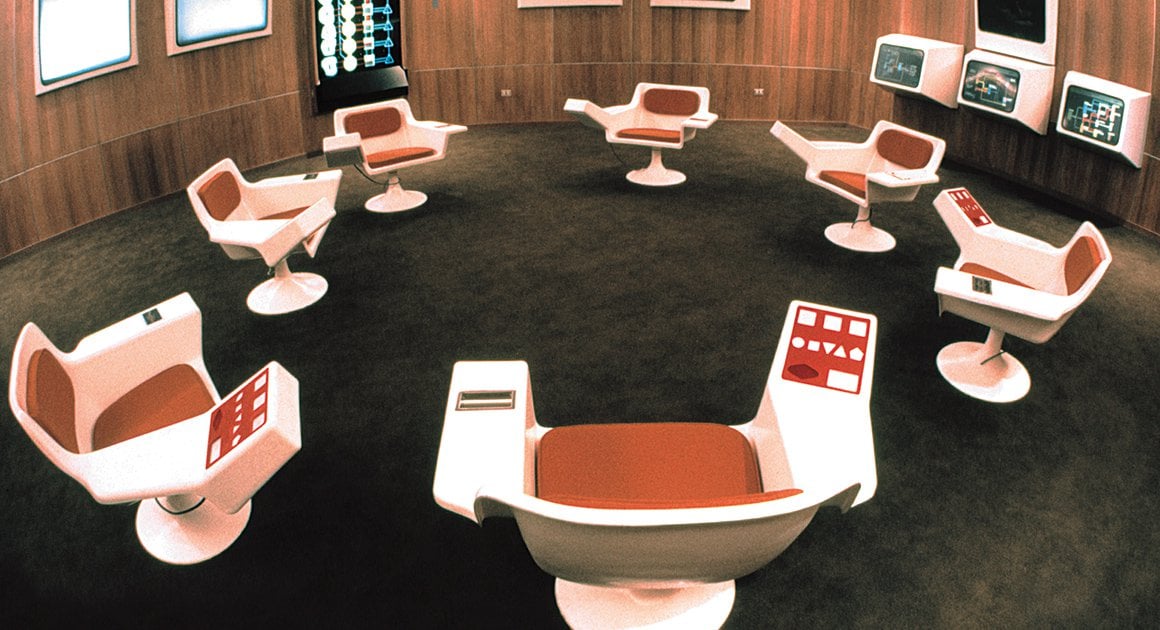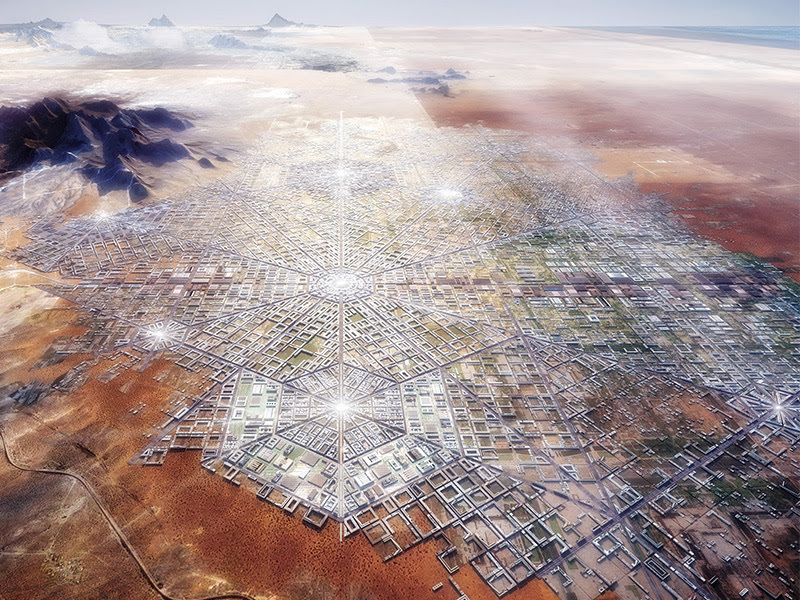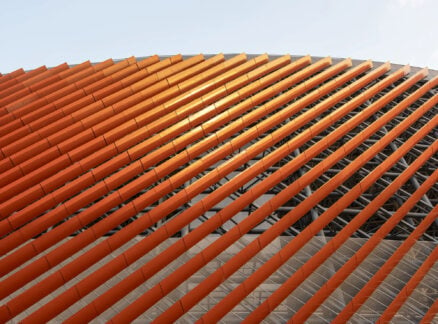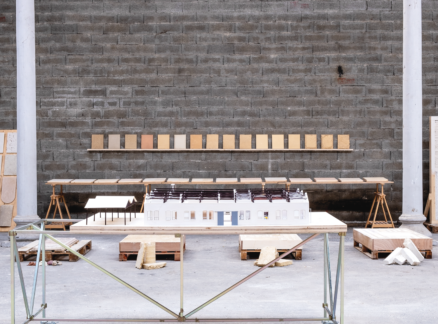
September 27, 2016
The London Design Biennale’s Utopian Dreams Land With a Thud
The inaugural biennial taps into a long legacy of utopian design, but fails to add anything to this tradition.
Held at the Somerset House, the first London Design Biennale celebrates the 500th universary of Thomas More’s Utopia. Above: Saudi Arabia’s Water Machine installation.
Courtesy Noura Bouzo
Five hundred years since the publishing of Thomas More’s Utopia, and only mere decades removed from the 20th century’s failed social projects, we moderns like to think we’re beyond utopian longings. We are, in any case, wise to the results of political reorganization driven by the goal of a perfected society. Yet utopias have historically served as both critiques of contemporary politics and provocative re-imaginings of current society. For its part, architecture has followed a more literal path to utopia, perhaps unavoidable given the discipline’s affinity for blueprints.
In recent years, however, two strands of design have pushed the architectural discipline in a more interesting direction, one geared toward unabashed speculation. Both speculative and critical design have opened up a new kind of discourse, with an explicitly future-oriented bent, that has prompted thoughtful, provocative questions about the natural world and our place in it. They reconsider our relationships to our pets, burrow into the hidden networks of labor and mineral exploitation behind our personal gadgets, propose refugee design strategies, and ponder the possibility of privacy in a networked world.
By focusing on critique over implementation, problematizing over problem-solving, these camps keep the spirit of utopian thinking alive while also repeating some of its oversights. For instance, critics charge that speculative and critical design are exclusively concerned with the viewpoint of white middle-class society while largely ignoring issues of class, race, and gender. Moreover, the two design currents often skirt the edge of solutionism, the act of providing overarching solutions to problems that may not even exist yet.
Such is the context into which the inaugural London Design Biennale (LDB) wades. It isn’t entirely clear that London even needs a design biennial, but that aside, one wonders what the Biennale, which is held at the imperious Somerset House, brings to this ongoing discussion. LDB director Christopher Turner promised that the programming would tackle the most pressing problems of the day by bringing together international designers to imagine “our future world” in the spirit of Utopia, which celebrates its 500th anniversary this year. That is a rather ambitious mission, and it’s clear that the event isn’t up to the task.
Quite quickly, one can see where the speculative and critical design naysayers have a point. Of the Biennale’s 37 participants, split up along national divides, about half are European. Africa is represented only by three countries: Tunisia, whose pavilion consists of 54 charred beams (after the 54 cities in Utopia) that ostensibly convey the fragility of utopias; Nigeria, whose interesting proposition on the environmental problems faced by river-based communities is poorly rendered by a bland wooden pavilion; and South Africa, whose hanging mammal-like pods (by studio Porky Hefer) whimsically embody the utopian ideal of leisure time. Meanwhile, South America’s only representative is Chile, and it brings a much-needed degree of historical context to the mix. Its installation recreates the Cybersyn control room, an economic data control center developed by Salvador Allende’s socialist government and newly rediscovered by design scenesters. While fascinating, it ultimately suffers from a lack of detailed information.

The Chilean pavilion recreated the Cybersyn Ops Room, an innovation of Salvador Allende’s brief socialist government.
Courtesy Gui Bonsiepe
Germany’s idea of utopia is Konstantin Grcic’s Elsewhere installation—literally, a room full of Konstantin Grcic chairs positioned in front of a digital fire. Belgium’s offering has lazily taken Oscar Wilde’s witticism—”A map of the world that does not include Utopia is not worth even glancing at”—and cobbled together its own cartography of utopia, featuring Germany, Finland, Italy, but also China and Uzbekistan. Editions for sale in the gift shop on the way out. America’s showing is frankly embarrassing, particularly because it comes from the Cooper Hewitt, Smithsonian Design Museum, a stalwart establishment for good design. Visitors to its interactive exhibit are encouraged to swipe through the institution’s wallpaper archive using a digital pen, the kind circulated to visitors to its New York galleries. The premise, though, is weak, with visitors presented with the freedom of home decoration as a kind of personal utopia.
Australian designer Brodie Neill throws away what could have been a profound provocation and reduces it to an uninteresting object. His project looks at the once-utopian potential of plastic, now a nightmarish material clogging up our seas. Rather than pursuing a more trenchant investigation into plastic’s social history, Neill has merely repurposed some bits of found oceanic waste into a terrazzo-inspired dining table.
Cuba’s installation, which draws attention to the increasing appearance of WiFi hotspots in Havana, also makes use of plastic. Designers Luis Ramirez and Michel Aguilar highlight the lack of street furniture where these hotspots exist in the capital. Unfortunately, the duo follow the worst tradition of designers attempting to solve a problem with a wholly unnecessary product; in this case, stackable plastic cubes meant to shelter WiFi users from environmental annoyances but which come across as small, isolating prisons. By comparison, photographs of the current situation that accompany the installation, in which people are sitting together on benches and stools using their mobile phones, look far more appealing and sociable than the hulking modules dreamt up by the designers.
If utopias are a comment on the present moment, what does it suggest that designers are ignoring the world’s most pressing dilemmas in favor of shelters for WiFi users? Even as the availability of natural resources is a pressing global concern, it is something of a surprise to see so few nations take up the theme. With the exception of Barber & Osgerby’s ineffectual, shiplike sculpture for Britain, intended to highlight the UK’s status as a major producer of wind power, only two other countries—Saudi Arabia and the United Arab Emirates—address scarcity of resources.

Fernando Romero Enterprise’s plan for new, hexagonal border cities between the U.S. and Mexico.
Courtesy FR-EE
The UAE presents a display on its ancient falaj, manmade irrigation channels used in desert regions to transfer water from the Gulf’s mountainous aquifers to towns and villages across the Arabian desert. Apparently the falaj have fallen out of favor, and the exhibition offers a series of architectural models as prompts for how these traditional water channels might be integrated into future urban developments. Saudi Arabia, on the other hand, thought to highlight the same problem but through a ponderous installation. The pavilion’s 10-foot-high gumball machine filled with blue-dyed spheres of water is a banal metaphor, to say the least.
As with natural resources, so too with questions of population density, immigration, refugees, and urbanization. Again, surely these are far more pressing issues than how to implement smart-city virtual realities, as the Spanish pavilion did? One might have expected that the utopian design imaginings of the 37 participating nations would have sought to engage such questions. Yet, only France, Mexico, and China paid them any attention. France’s The Astounding Eyes of Syria is a poetic look at the displacement caused by the war in Syria through an endearing entrypoint—local candies. Designer Benjamin Loyauté visited displaced Syrians and filmed their remembrances of home, specifically their traditions and rituals related to sweets. To raise further awareness and funds, in what is perhaps a sincere (and probably wry) comment on the nature of Western charity, visitors are invited to purchase candy from a nearby vending machine.
Mexico has a well-intentioned, if confusing, study by Fernando Romero Enterprise (FR-EE) for cities along the US-Mexico divide. Given the current political climate, with Trump threatening to build a wall between the two countries, it’s heartening to see FR-EE’s master plan imagine a new model for border-straddling cities which promotes employment, trade equality, and freedom of movement while also embracing density and sustainability. China’s display of “sustainable megastructures” by the architecture firm Urbanus was similarly urban-minded and intriguing. The designs depicted high-density urban living proposals for Shenzhen, a city whose population has rocketed from 300,000 to 17 million in just over 35 years.
“The totalitarian world…is a world of answers rather than questions,” wrote Milan Kundera in The Book of Laughter and Forgetting. Although he was referring to the lack of interest in novels within bloc states, the same could be said of both the dark side of utopian programs, as well as the heavy-handed, misguided solutionism so often present in design biennials. The best critical and speculative design projects present a possible future, but in so doing also offer up a host of important questions which help to undercut assumptions or rethink contemporary values. In seeking to link itself with utopia, the first ever London Design Biennale places itself within a historical context of creative and critical questioning in a city which already has an extremely rich tradition of such activity. Unfortunately, however, most of its installations provide only answers. And not very good ones at that.
Recent Viewpoints
Viewpoints
Sustainability News Updates for Q2 2025





